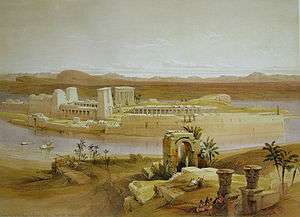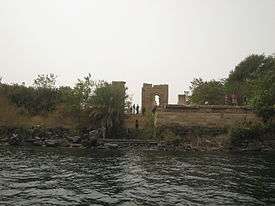Bigeh

Bigeh (Arabic: بجح; Ancient Egyptian Senem,[1]) is an island and archaeological site situated along the Nile River in historic Nubia, and within the Aswan Governorate of southern Egypt. The island has been situated in the reservoir of the Old Aswan Dam, since the dam's initial completion in 1902.[2][3]
Ancient Egypt
It was formerly an island in the First Cataract of the Nile River, and its fortification controlled the access to ancient Upper Egypt and Nubia. It is a World Heritage Site, located close to Philae and Agilkia Islands and their ancient archaeological sites in the reservoir.[4]
Bigeh island was sacred to the ancient Egyptians.[5] There was a belief that Osiris was buried on the island.[6]
The god Thoth bore the epithets of "Great and Splendid God in Bigeh" and "He that Pacifies the Nsr.t in Bigeh".[7] It is thought that there may have been a Temple of Thoth on the island.

References
- ↑ Heinrich Karl Brugsch, Reiseberichte aus Aegypten, Olms 1855, p.268
- ↑ Sidney Peel,The Binding of the Nile and the New Soudan, p.76 (1904)
- ↑ Canay Ozden, The Pontifex Minimus: William Willcocks and Engineering British Colonialism, p. 196, Annals of Science, 2013. DOI: 10.1080/00033790.2013.808378
- ↑ Yale University Publications in Anthropology, Yale University 1936, p.96
- ↑ The Island of Bigeh, www.philae.nu, date unknown, (accessed 17 February 2014 from archive.org)
- ↑ Anne Burton, Diodorus Siculus, Brill 1972, p.95
- ↑ Patrick Boylan, Thoth Or the Hermes of Egypt, 1922, p.169
External links
| Wikimedia Commons has media related to Island of Bigeh. |
Coordinates: 24°01′16″N 32°53′06″E / 24.021°N 32.885°E